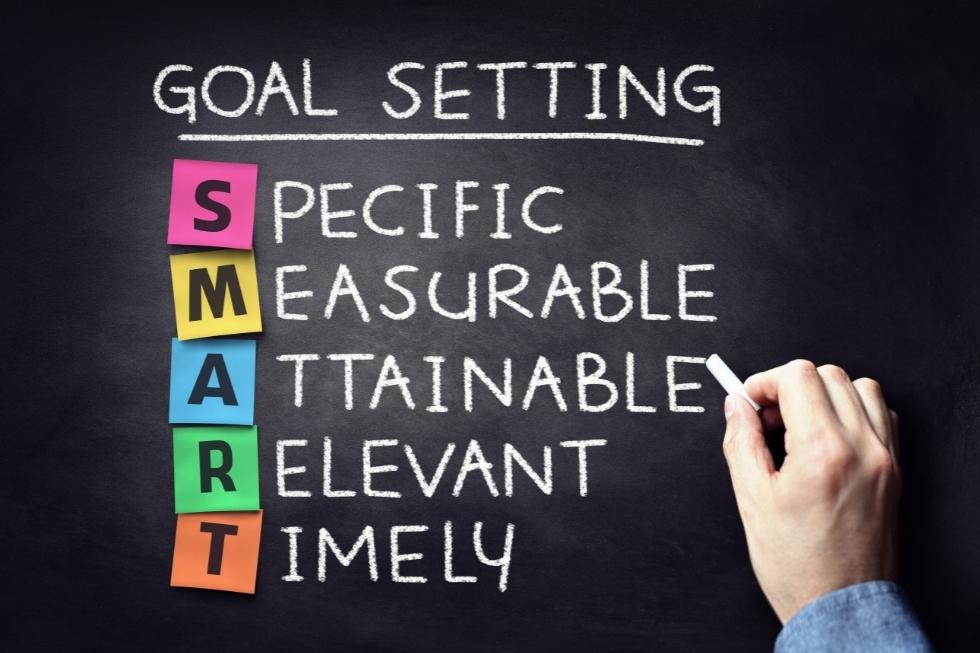
Let’s get to the point: These SMART goal examples can assist you in achieving your goals.
How? Because they can help you to develop strong goals that produce results.
Why should this concern you?
If you don’t write SMART goals down, you’re setting yourself up for failure.
You’ve heard it many times, haven’t you?
“If you fail to plan, you intend to fail.”
It’s also important that you understand the difference between dreams vs goals.
Sure, but what exactly is a SMART goal, and how can it assist you to achieve what you want in life?
This post will look at nine-strong SMART goal samples and show you how to write a SMART goals for any purpose.
Let’s dive in.
Table of Contents
What Is a SMART Goal?
Let’s take a step back and look at SMART goals before giving you some examples.
What are the meanings of the initials “SMART”?
Specific: describing or defining something that can be measured in some way.
Measurable: able to be quantified Relevant: relevant to the situation
Achievable: capable of being accomplished in an acceptable period Time-bound: having a deadline
Let’s explore each characteristic a little further.
- Specific: The objective should be very clear and simple to understand, with no confusion possible.
- Measurable: The objective should be measurable, and the development process should be transparent.
- Achievable: The objective should be something that you can attain — not impossible or unachievable.
- Relevant: Your aim should contribute to your organization’s overall objectives.
- Time-bound: The end date for the goal should be specified.
Why Are SMART Goals Important?

Goal setting framework
Why should you use SMART goals?
First, you’ll get clarity when you utilize a goal setting framework.
Setting a SMART goal will assist you in determining exactly what needs to be done (and when it needs to be done) to achieve your intended result.
According to Zig Ziglar, motivational instructor and trainer, a goal that has been correctly set is halfway completed.
However, if your goals aren’t SMART, they’re… well, not so smart!
Goals that aren’t SMART are usually more like wishes and resolutions than actual objectives; they make us feel good to write, but they’re nearly impossible to put into action.
In a nutshell, you’re more likely to succeed if you make it SMART.
What happens if you don’t set SMART goals?
If you don’t utilize a framework setting and achieving goals, one of the following things will happen:
- Nothing
- Something will happen, but it’s not what you want.
- You’re partly successful.
- Your goal achievement will take much longer.
The key to developing a SMART objective is to get it right the first time.
If you don’t, you’ll probably waste a lot of time and energy looking for something that isn’t there.
SMART goals have several advantages, including greater:
- focus and clarity
- increased motivation
- better chance of success
The fact that SMART objectives help you define reasonable expectations for yourself is at the heart of these benefits.
10 Effective SMART Goal Examples

Let’s look at some SMART goal examples to get you started.
These ten SMART goal-setting examples show how to make strong personal, professional, job, and leadership goals.
Personal SMART Goal Examples
Here are some samples of personal SMART goals to demonstrate how you may improve virtually anything in your life.
1. Achieve a Personal Project
Weak Goal Example: I’m going to write a book.
SMART Goal Example:
- Specific: I’m going to write a 60,000-word sci-fi book.
- Measurable: In 6 months, I will have completed writing 60,000 words.
- Achievable: I’ll write 2,500 words each week.
- Relevant: My childhood ambition was to be a well-known author.
- Time-bound: I will begin writing on January 1st and conclude on June 30th.
SMART Goal Example Summary:
I will write a 60,000-word book in 6 months and finish on June 30th. I will accomplish this by producing 2,500 words each week.
2. Improve Relationships
Weak Goal Example: Relationships are going to be enhanced.
SMART Goal Example:
- Specific: I’ll get to know David, Sarah, and mom.
- Measurable: I’ll call each of these individuals twice a week.
- Achievable: We have plenty of topics to discuss, but we’d always love to speak more since we talk to these people daily.
- Relevant: I want to develop deeper social connections, experience more love and support in my life, and assist those I care about.
- Time-bound: I’ll stick to this strategy for three months, then reassess and devise my next moves.
SMART Goal Example Summary:
I’ll call David, Sarah, and my mother twice a week for three months to strengthen our connection.
3. Get Fit & Strong
Weak Goal Example: I’m going to get fit.
SMART Goal Example:
- Specific: I will begin running regularly and train for a marathon.
- Measurable: I will complete a full marathon without stopping using the Nike app’s training program.
- Achievable: Because I am a runner, I have done some before, my body is in good condition, and the marathon is six months away.
- Relevant: I’m ready to stretch and grow, embracing my body’s limitations and improving on what I can do. -> I’m eager to pursue fitness, health, and strength — I want to be full of life, vitality, and enthusiasm for a living!
- Time-bound: I’ve registered for a marathon in six months.
SMART Goal Example Summary:
I will complete a marathon in 6 months without stopping if I do everything according to the Nike app training program.
Business SMART Goal Examples
Whether you’re starting a business or expanding one, a few business SMART objective samples can get you started.
1. Start a Business
Weak Goal Example: I’m going to start a business.
SMART Goal Example:
- Specific: “I’m going to start a dropshipping company.”
- Measurable: I’ll devote one hour every day to developing my business, and the objective is for me to secure my first sale within two weeks.
- Achievable: Dropshipping has piqued my attention, and I’ve seen a few videos. nI’s aware that Shopify may be used to start a firm quickly.
- Relevant: I’d like to leave my day job and be my boss.
- Time-bound: On Saturday, I will start and complete my first transaction within two weeks.
SMART Goal Example Summary:
I’ll start a Shopify dropshipping company on Saturday. I’ll devote one hour to this endeavour each day, aiming to make my first sale in two weeks.
2. Market a Business
Weak Goal Example: I’m going to increase my sales.
SMART Goal Example:
- Specific: I’m going to figure out how to utilize Facebook Ads and put 30% of my earnings into this marketing approach.
- Measurable: The aim is to increase my revenue by 50% in three months.
- Achievable: I have a modest company prepared to expand in sales.
- Relevant: I’m looking to make six figures each year as a work from home.
- Time-bound: At the end of the day, it’s important to establish a healthy working relationship with your audience. If you’re not connecting with people who have similar interests and aren’t responding to your content, why would they care about what you’re saying? At that point, it’s time to start generating leads and growing your business in different ways.
SMART Goal Example Summary:
I’ll start learning about Facebook Ads and investing 30% of my company profits into sponsored marketing within the next week. I will continue learning and investing in Facebook Ads to increase my revenue by 50% in three months.
3. Grow a Business
Weak Goal Example: I’m going to expand my company.
SMART Goal Example:
- Specific: I’m going to outsource customer support inquiries to a virtual assistant (VA) to free up time for product research and introduce new items in my store.
- Measurable: I’m looking for a virtual assistant who can help me with small projects. I want to add five new items to my store, and I’ll pay you $200 per month.
- Achievable: I understand how to discover great items, and I’ve worked with freelancers before on Upwork.
- Relevant: I’m not interested in developing my business. Instead, I’d like to work on it so that I may increase my income and work fewer hours.
- Time-bound: I’ll recruit a V.A. within two weeks after that. I’ll add five new items to my shop in a month.
SMART Goal Example Summary:
I’ll hire a virtual assistant to handle client service inquiries in two weeks. Before the month is out, I’ll use this period to research and add five new items to my business.
SMART Goal Examples for Work
Here are some professional SMART goal examples for you to use in your job to help you advance.
1. Land a Dream Job
Weak Goal Example: I’m going to find a better job.
SMART Goal Example:
- Specific: I will work as a search engine optimization (SEO) specialist for Shopify, an industry-leading software-as-a-service (SaaS) firm, and work remotely.
- Measurable: I will apply to a minimum of 8 job applications in two months.
- Achievable: I’ve spent the past two years working as an SEO specialist in an accounting firm’s office, and I’m good at what I do.
- Relevant: I’m looking for a company that values my contributions and allows me to grow. I want to work with interesting individuals, contribute to something new, and be a part of a firm where I can develop. Furthermore, I wish to live as a digital nomad long-term.
- Time-bound: I will submit one application per week to eight appropriate employment applications within two months.
SMART Goal Example Summary:
I will apply for one job per week for the next two months—eight applications to make this a reality.
2. Earn a Promotion
Weak Goal Example: I’m going to get a raise.
SMART Goal Example:
- Specific: I will be a senior SEO specialist after I accomplish this goal.
- Measurable: I will finish the training and submit my application. I’ll also take on a supplementary job to demonstrate that I’m ready to handle greater responsibilities.
- Achievable: I’ve been working as an SEO expert for three years and have seen good results. On the other hand, my firm is searching for another senior SEO specialist at the end of this quarter.
- Relevant: As I advance in my profession, I want to continue learning and pushing myself.
- Time-bound: I will take on one more job project within the next two weeks, complete the necessary training in 6 weeks, and submit my application within eight weeks.
SMART Goal Example Summary:
I’ll get a position as a senior SEO specialist at my firm if I land this promotion. By completing an additional work project within two weeks, undergoing the necessary training by the end of September, and submitting my application by the end of August, I will be able to do so.
Leadership SMART Goal Examples
Here are some real-world instances of SMART objectives for leaders to see how they might manage a group effectively.
1. Improve Team Results
Weak Goal Example: I’m going to assist my company in achieving more sales.
SMART Goal Example:
- Specific: I’m going to assist my staff in getting more sales leads that result in customer purchases.
- Measurable: The objective is to boost the team’s sales by 5%.
- Achievable: We’ve discovered the primary reason why our leads fail to buy: they don’t exactly match our target market. If we can guarantee that everyone we contact fits our target market, we will certainly have more sales.
- Relevant: We’re striving for a sales growth rate of at least 20% in 2012.
- Time-bound: Tallying data will help you gain a deeper understanding of customer behaviour and needs, which is critical to the effectiveness of your marketing strategy. We’ll increase sales by 5% within three months before rethinking our approach.
SMART Goal Example Summary:
I’ll take my crew and teach them how to enhance our qualification procedure so that we only contact high-quality leads who are likely to buy. We want to improve sales by 5% in three months.
2. Manage a Team Effectively
Weak Goal Example: I’m going to assist the team in better communicating.
SMART Goal Example:
- Specific: I’m going to assist the team in communicating more effectively, which will save time that is now being wasted on communication problems. As a result, the team can focus on its essential duties rather than wasting time on nonessential activities.
- Measurable: According to our time-tracking software, team members spend 1.5 hours each day on email. To reduce the time to 45 minutes a day, we must halve it.
- Achievable: With a team messaging solution like Slack, we can avoid the confusion caused by lengthy email chains. If we use a messaging system, we’ll likely be able to cut down on email time significantly.
- Relevant: I’d want to enable my team to produce their best work and have a bigger influence by reducing time wasted on needless and ineffective activities.
- Time-bound: Within two weeks, we’ll set up a messaging system, and the time it takes to communicate will be cut in half within a month.
SMART Goal Example Summary:
Within two weeks, I will put in place a team messaging solution to enhance communication and save time. Within a month, the aim is for teams to save 45 minutes each day by reducing the amount of time spent on messaging from an average of 1.5 hours each day to just 45 minutes per person.
Summary: How to Write a SMART Goal
What are SMART goals, and how do they work? To put it another way, they may assist you in gaining clarity on your objective and ensuring that you follow through on your objectives.
In conclusion, here are the five easy stages to follow when learning how to make effective goals:
- Specific: Decide what you want.
- Measurable: Consider your life, and decide what you define as success.
- Achievable: Check to see whether your goal is sensible.
- Relevant: Ensure that your objective is consistent with other objectives in your overall plan.
- Time-bound: Set a deadline and make a timetable.
It’s your turn now! Make a SMART goal to help you get closer to your ideal life or business.
Guiding Questions for Developing S.M.A.R.T.S
Examine each goal to determine whether they are S.M.A.R.T., in terms of the primary goal/s of your project, to help you prioritize tasks and hours needed for their completion.
1. Is your goal specific? If you have a clear objective, you can probably answer the following five questions:
- What: What exactly do you want to achieve?
- Why: What are the reasons, goals, or advantages of achieving the goal?
- Who: What is the purpose of this study? Who is involved in this project? What are the stakeholders’ interests and concerns?
- Where: What is the future hold?
- Which: What factors should we include? (Requirements and limits; hazard and protection factors)
2. Is your aim measurable? If your goals are clear and quantifiable, you should be able to establish precise standards for assessing how close you are to achieving each one.
- How will you know when the goal has been achieved?
- What indicators will you use to measure your progress and success?
- Is there easy access to data that will allow you to track and assess your progress and success? Do you need to create new metrics, such as questionnaires, focus groups, or other approaches to measure your progress and success?
3. Is it possible for you to accomplish what you want? Your goal must be realistic and feasible, considering the resources available to you.
- Do you have enough money to complete your goal?
- Do you have competent personnel that are able and qualified to complete your goal (including evaluation)?
- Do you have enough time to complete your goal?
- What additional resources do you require to achieve your goals (technology, space, or equipment)?
4. Is your goal focused on the result? Is yours focused on the ultimate objective? Finally, your objectives should assist you in achieving your major project aim(s).
- What is the significance of this?
- Is it worth your time to pursue?
- Is this the right moment?
- Do they have a similar goal?
5. Is there a deadline for your goal? Objects should have a start and end date and specified duration.
- When will you be able to complete this goal?
- When will we start working toward our goal?
- When can we expect to begin seeing short-term results? Example:
Goal 1: To reduce the dropout rate of at-risk students in grades 9-12 at Washington High School
Objective 1.1: Consequently, the school’s attendance rates will be at 100%.
Objective 1.1: The school’s attendance rates will rise to 100% due to the program.
Objective 1.1: Attendance rates for at-risk youngsters at Benedictine High School in grades 10, 11, and 12 will improve by 2% after the apprenticeship/coaching program is established.
Is the objective…
Objective Specific? Measurable? Attainable? Result-oriented/
Relevant?
Time-Bound?
As a result of the program, Benedictine High School’s attendance rates will be 100%.
Yes
No, revise
Yes
No, revise
Yes
No, revise
Yes
No, revise
Yes
No, revise
The attendance rate at Benedictine High School will go up by 2% the following year after the apprenticeship/coaching program is created.
Yes
No, revise
Yes
No, revise
Yes
No, revise
Yes
No, revise
Yes
No, revise
Attendance rates for at-risk youngsters at Benedictine High School in grades 10, 11, and 12 will improve by 2% the next year after the apprenticeship/coaching program is established.
Yes
No, revise
Yes
No, revise
Yes
No, revise
Yes
No, revise
Yes
No, reviseWorksheet
Goal:
Objective:
Is the objective…
Objective Specific? Measurable? Attainable? Result-oriented/
Relevant?
Time-Bound?
Yes
No, revise
Yes
No, revise
Yes
No, revise
Yes
No, revise
Yes
No, revise
Yes
No, revise
Yes
No, revise
Yes
No, revise
Yes
No, revise
Yes
No, revise
Yes
No, revise
Yes
No, revise
Yes
No, revise
Yes
No, revise
Yes
No, revise
Yes
No, revise
Yes
No, revise
Yes
No, revise
Yes
No, revise
Yes
No, revise
Next Steps…
• Examine your remaining Objectives to make them SMART!
• The value of evaluation can be found in many ways, but it’s primarily used to give continuous, valuable feedback on your project and show that your endeavour made a difference.
• Examine your project’s SMART goals and identify data sources, timelines, and folks accountable for collecting, analyzing, and reporting data on the project.
– Assign buy-in to these new measures, if appropriate.
Time management is essential to the success of any project. Establish a timeline for completion, administration, and analysis.
• As you distribute accountability, consider that evaluation is a collaborative effort rather than simply one person’s responsibility.
• On your next meeting agendas, include a discussion of how to evaluate things. Take some time out of each meeting to discuss where you are in your project, what data you’ve gathered so far, what it indicates and how you’ll use the information, and what else you need to know.
Faqs
What are some examples of successful business goals?
One smart objective might be to pay down the company’s debt, allowing more money to flow into employee raises and other projects. Specific: Pay off $10,000. Numeric: We may keep track of our progress by monitoring our cash accounts and comparing how we are doing from month to month.
What are good examples of SMART goals?
SMART Goal Example:
- Specific: I’ll write a 60,000-word sci-fi novella.
- Measurable: In six months, I’ll have completed 60,000 words.
- Achievable: I’ll write 2,500 words each week.
- Relevant: I’ve always wanted to be a professional author.
What is an effective smart goal?
The six letters in SMART goals are specific, measurable, attainable, relevant, and time-bound. These terms refer to your goal’s parameters to ensure that it will be accomplished within a specific timeframe.
What are some excellent company objectives?
6 most common types of business objectives
- Increase the market share of your product or service.
- Encourage teams to develop their leadership abilities by providing chances to do so.
- Reduce employee turnover and boost employee morale.
- Extend your reach to more community members.
- Grow sales and profits.
- Improve customer service.
What are the five smart goals in business?
The acronym “SMART” stands for “specific,” “measurable,” “attainable,” “pertinent,” and “time-bound.” To ensure that the objective can be achieved and benefit the employee, each SMART aim must possess these five features. Discover what each term means and how to construct a SMART goal that exemplifies them.
How to set a smart goal for your life or business
A smart goal is specific, measurable, attainable, relevant, and time-bound. To set a smart goal, you will need first to identify what you want to achieve. Once you have done this, you need to ask yourself if the goal is specific and measurable. Can you break the goal down into smaller steps to track your progress? If so, then the goal is specific and measurable. Next, ask yourself if the goal is attainable and relevant. Do you have the resources and ability to achieve the goal? If so, then the goal is attainable. Finally, ask yourself if the goal is time-bound. That is, do you have a deadline for achieving the goal? If so, then the goal is time-bound. You can ensure that your goals are smart and achievable by following these steps.
What are the benefits of setting and achieving a smart goal for your life or business?
A goal is a desired result that a person or a team of people envision, plan and commit to achieving. A smart goal is a goal that is specific, measurable, achievable, relevant, and time-bound. Setting and achieving a smart goal can provide numerous benefits.
When a goal is specific, it is easier to visualize and, therefore, easier to work towards. It is important to be as clear as possible about the desired outcome. For example, rather than setting the goal of “losing weight”, it would be more specific to set the goal of “losing 10 pounds in 3 months”.
Measuring progress is important to track whether or not the goal is being achieved. This can help to identify any roadblocks or challenges that need to be addressed along the way. It can be difficult to tell if a goal is achieved without measurement.
Ensuring that a goal is achievable is important to maintain motivation levels. If a goal seems unattainable, it can easily become discouraged and give up. However, if a goal is achievable but challenging, it can provide a sense of satisfaction and accomplishment when it is finally achieved.
Examples of how to apply the principles of setting and achieving a smart goal to your life or business
Many principles are involved in successful goal setting and achievement. At the core of this process is the ability to develop clear, realistic goals that are aligned with your values and aspirations. Additionally, it is important to have a strong sense of self-discipline and determination and a positive, growth-oriented mindset that allows you to learn and improve continuously. These principles can be applied to any area of your life or business, whether your relationships, work projects, health and fitness goals or financial aspirations.
One effective way to apply these principles is by breaking your overarching goals into smaller action steps. For example, if you have a long-term goal of starting your own business, you might set yourself the goal of developing a marketing plan within the next six months. This can involve creating research plans and schedules for researching potential markets and gathering the resources you need for strategic marketing campaigns. By making a focused effort to achieve specific milestones along the path towards your overall goal, you can stay motivated and keep moving forward even when challenges arise.
Another key element in successful goal setting is proper support structures to provide accountability.
Tips on how to stay focused and motivated when working towards a smart goal
One of the key skills needed to achieve any meaningful goal is to focus and stay motivated. This can be particularly challenging when working towards a smart goal, which may seem far off or even unattainable at times. However, incorporating certain tricks and habits into your routine makes it possible to stay in top form and keep yourself on track for success. Some useful tips to help you stay focused and motivated include breaking up large tasks into smaller components, setting SMART goals for yourself, taking regular breaks to rest and recharge, surrounding yourself with positive people and influences, and prioritizing self-care activities like exercise. With these strategies in place, you can give yourself the best chance of reaching your goals and realizing all of your dreams.

Petri Maatta is a photographer, filmmaker, and webdesigner who has been working for over 20 years in the creative industry. Fascinated by manifesting for business reasons, Petri was determined to find out what it took to create success. He started his career with seven years of business failures before he found success by learning about manifesting from a mentor with a Fortune 500 company. Today Petri shares his knowledge through DreamMaker courses designed to help people change their businesses and lives while living on their terms.
STAY IN THE LOOP
Subscribe to our free newsletter.
Stay up to date! Get all the latest & greatest posts delivered straight to your inbox


